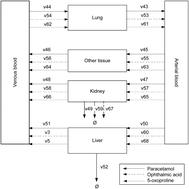Multiscale modelling approach combining a kinetic model of glutathione metabolism with PBPK models of paracetamol and the potential glutathione-depletion biomarkers ophthalmic acid and 5-oxoproline in humans and rats†
Abstract
A key role of the

* Corresponding authors
a Manchester Centre for Integrative Systems Biology and Doctoral Training Centre ISBML, Manchester Interdisciplinary Biocentre, University of Manchester, 131 Princess Street, Manchester, UK
b Drug Metabolism and Pharmacokinetics IM, AstraZeneca, Mereside, Alderley Park, Macclesfield, Cheshire, UK
c
Oncology iMED DMPK, AstraZeneca, Mereside, Alderley Park, Macclesfield, Cheshire, UK
E-mail:
james.yates@astrazeneca.com
d Global Safety Assessment, Innovative Medicines, AstraZeneca R&D, Alderley Park, Macclesfield, UK
e Chair of Mathematical Modeling for Systems Toxicology, Université de Technologie de Compiègne, Royallieu Research Center, 60200 Compiegne, France
f INERIS, 60550 Verneuil-en-Halatte, France
g Dept of Surgery and Cancer, Sir Alexander Fleming Building, Imperial College, Exhibition Rd, South Kensington, London, UK
h Molecular Cell Physiology, VU University, Amsterdam, The Netherlands
i Systems and Synthetic Biology, FNWI, Universiteit van Amsterdam, The Netherlands
A key role of the

 Please wait while we load your content...
Something went wrong. Try again?
Please wait while we load your content...
Something went wrong. Try again?
 Fetching data from CrossRef.
Fetching data from CrossRef.
This may take some time to load.
Loading related content
